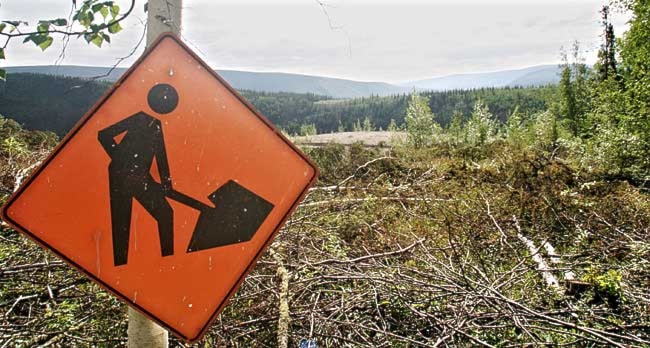DAWSON CITY
This town’s authority over the Slinky placer mine has been effectively “neutered” by the Yukon government, says Mayor Peter Jenkins.
Last Friday, the Yukon Territorial Water Board gave miner Darrell Carey permission to start work on his Slinky mine on Dawson’s Midnight Dome subdivision.
The decision left council scrambling to do whatever it can to restrict the mine’s operations.
“The city’s hands are tied,” said Jenkins following a special council meeting Monday night.
“The only area we have rights over at this point is the highway (the Dome Road), which is owned by the city.”
In the fall, Carey applied to drastically expand placer operations on the Dome including a plan to rip up the Dome Road to mine for gold. Nearby residents were concerned about safety and noise, and argued the operation would lower their property values.
The surrounding area has at least 70 homes and many recreation trails.
Until last Friday, Dawson maintained it could control the size and extent of Carey’s development because it falls within town limits.
On June 9, town council drew up a list of restrictions Carey would have to fulfil when applying for permits to work the land. Those included minimum setbacks from homes and roads, engineered drawings explaining how Carey will rebuild the Dome Road before he starts mining, and a bond to the town that would act as advance payment for rebuilding the road.
It proved a useless exercise.
Two days later, the water board ruled Dawson had no jurisdiction over Carey’s mining operation. The Yukon’s placer mining legislation trumps municipal bylaws, the board said in its decision document.
The board even went as far as scrapping the word “municipal” from a section of Carey’s licence dealing with territorial, federal, First Nation and municipal permitting.
“The reference to ‘municipal’ was removed to avoid any ambiguity between the board’s jurisdiction.
But the wording of the document is ambiguous, said the town’s chief administrative officer Jeff Renaud.
“In one section it says the city can impose restrictions on the licence while the next page says restricting activities further (from what the water board dictated) would verge on refusing the claimholder his mineral rights,” he said.
The water board ruled Carey can mine within 100 metres of any residence - 200 metres less than what some homeowners, like Glenda Bolt, demanded from the board.
It also implemented a 15-metre-wide buffer from the midline of the Dome Road and a 10-metre buffer on Mary McLeod Road, far less than the city wanted.
Monday, councillors voted to legally pursue Carey if he encroaches on the Dome Road. They sought a 60-metre buffer along the Dome Road and a 30-metre buffer on the adjoining Mary McLeod Road.
The resolution came after the permitting restrictions were voted down by councillors.
The Dome Road, as a public utility, is one piece of land the city technically has control over, said Jenkins.
“It appears that some of the licensing boards consider the Dome Road a mining road - it’s not.”
The city should have a role in how the mine is developed, said councillor Wayne Potoroka.
“Someone is going to dig up our road, we want to make sure it’s going to be replaced,” he said.
“It’s a road that school buses drive on and that take people to work. We want to make sure it’s adequate for public travel.”
He’s worried the Slinky mine could be precedent setting for other outstanding placer claims in Dawson and in other areas of the Yukon where claims have been staked within municipalities.
The government should be initiating a conversation with the city on the issue and they’re not, said Potoroka.
In April, the Yukon Environmental and Socio-Economic Assessment Board recommended the government not allow Carey develop his Slinky placer mine. They also turned down a simultaneous application to the board to develop a new housing subdivision on the Dome.
The government turned a blind eye to both recommendations, saying both developments should go ahead.
“If you look at every decision that’s come down - the YESAB decision to not grant Carey’s operation as well as the decision on the subdivision - both were reversed 180 degrees in Whitehorse,” he said.
“Even the recommendations for buffers that were established at the local level were amended and shortened by senior levels of government.”
In addition to reducing buffers for homes and roads, the board also ignored the city recommendation to mine at least 300 metres from Dawson’s old dump site on the Dome.
The town was concerned about the potential for contaminants from the dump leaching into the surrounding land and water.
The board also refused a request by the town and several residents to hold a public hearing on the issue.
“I think (all of council) is disappointed that there is no public hearing,” said councillor Bill Kendrick on Tuesday.
“People still want to see a public conversation about mining within municipalities.”
The Yukon water board recommended Carey get a five-year licence instead of a 10-year licence.
Carey can begin operations on the mine as soon as he completes all necessary permitting for the mine.
Contact Vivian Belik at
vivianb@yukon-news.com
